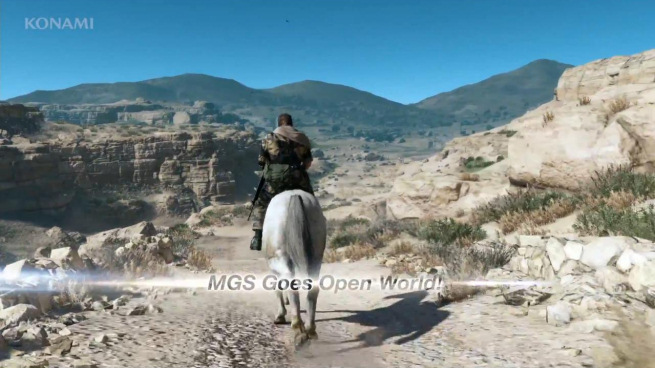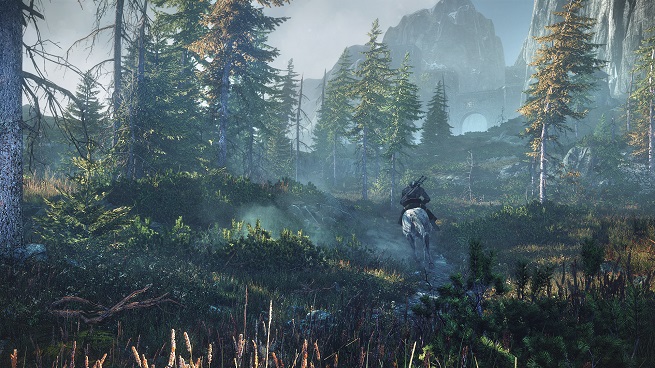
Check out all of our E3 2013 coverage here.
Last year, the gaming community declared that 2012’s Electronic Entertainment Expo trade show (E3) ushered in “the year of the bow.” We just finished up this year’s event, and while it was far less full of twings and/or twangs (unless Alice in Chains frontman Jerry Cantrell’s guitar performance at the Ubisoft presentation counts, which it might), one thing kept coming back through all of the press briefings, floor demos, and previews.
Seriously, did you notice all of the open-world games?
Sure, we saw the ones we expected, like Assassin’s Creed IV, Watch Dogs, Infamous: Second Son, and Saints Row IV. But we knew about these free-roaming titles going into the show, so we had no surprises there. As the week went on, however, we saw both new franchises and new installments of established series going the open-world route. Games like these:
Metal Gear Solid V: The Phantom Pain
(PlayStation 3, PlayStation 4, Xbox 360, Xbox One)
The lead-up to the reveal of Konami’s latest in its stealth-action franchise has been almost as complicated as the series’ plot. We’ve had an investigation-launching fake-out trailer at the Spike Video Game Awards in December, some confusion as to exactly how many games we were talking about, and a switch in voice actors. By the time we actually got to see the game in action at the start of the Microsoft press briefing on Monday, it was actually a little anticlimactic.
Well, it looks pretty good, actually. I can’t pretend it doesn’t. And what was the first thing that the gameplay video proclaimed once it got its expository dialogue out of the way?

Konami is right to throw that exclamation point in there; this is a big deal. The Metal Gear series is far from being the most linear around, but it has followed a pretty strict “go here, do this” structure in which players follow a prescribed sequences of events with lengthy cutscenes between them. It’ll be interesting to see how much freedom this translates to once the game actually comes out.
Whatever it means, however, I’m pretty sure the plus-sized cinematics are staying. Let’s just take one series-changer at a time here.
The Witcher 3: Wild Hunt
(PC, PlayStation 4, Xbox One)
Developer CD Projekt RED’s Witcher series of role-playing games has always been fairly open, but the designers apparently thought they could do more. “You can get to every place you see on the screen,” one of the developers said during a live demonstration of the upcoming game at E3. “This is a massive improvement in comparison to Witcher 2, which had some artificial barriers.”
CD Projekt wasted no opportunity to talk up the size of The Witcher 3’s world, claiming that it is 35 times larger than the previous game in the series and 20 percent larger than the open world in the developer Bethesda’s The Elder Scrolls V: Skyrim, which is the current standard for the “go ahead and get lost in the woods/hills/mountains for a few hours” gaming experience.

CD Projekt aims to improve on that experience, however — or, at least, bring some more to it. “Skyrim, which I think we all love, is a rather short game in terms of the main storyline,” gameplay producer Marek Ziemak said. “If you just want to focus on that element and you’re not that interested in exploring the world, it’s not that big. But that’s the core of The Witcher 3: the main story. It’s 40, 50 hours, plus the open world.”
Dying Light
(PC, PlayStation 3, PlayStation 4, Xbox 360, Xbox One)
If you’ve read Richard Matheson’s 1954 novel I Am Legend, you might remember this scene: Hero Robert Neville, convinced that he has enough time to make it to the safety of his fortified home before the legion of vampires that used to be the human race rose up from their lairs to murder him, realizes with horror that his watch has stopped.
That’s the feeling that developer Techland seems to be going for in Dying Light, a game that substitutes zombies for Matheson’s vampires and throws in some free-running. The game switches between two stages: exploration and preparation during the day and stealth and hasty retreats from high-powered superzombies at night.

Dying Light is about scavenging through the world to locate resources, supplies, and materials to build weapons before the sun goes down. Unlike CD Projekt, Techland is keeping quiet about the size and scope of its world, but we’re sure to hear more soon.
Driving games
E3 saw several new driving games, including the latest releases from Microsoft’s Forza series and Sony’s Gran Turismo, but the two that belong here are Need for Speed: Rivals and The Crew.
Open-world vehicle games are not without precedent. Developer Criterion’s Burnout Paradise was one of the first major releases to cut players loose in a virtual city to complete challenges in any order they pleased. Surely enough, Criterion’s first foray into the Need for Speed franchise, Most Wanted, was also an open-world racer. Rivals, developed “in association with” Criterion, looks like it will combine single- and multiplayer modes in interesting ways, with players driving around on their own one moment and then jumping into a high-speed chase against an online opponent the next. It comes out this November for current-gen systems with next-gen versions to follow.

The Crew, which publisher Ubisoft revealed at its press briefing, is shaping up to be an even more ambitious title for PC and next-gen systems that involves joining up with your friends to create a Fast-and-the-Furious-style … well, crew. Developer Ivory Tower’s creative director Julian Gerighty described the in-game world as “as big as has ever been created.” But nobody tell CD Projekt RED he said that.
Once you’ve gotten your crew together, your ragtag group of misfits can take on other teams in a variety of driving challenges like races and takedowns. You can roll to each other’s aid in locations including New York, Miami, Las Vegas, and the Black Hills. It also includes a single-player mode, but Ubisoft’s focus at the event was on four people taking on a fifth in a free-form pursuit across a large city map.
… And the rest
So many more companies announced, revealed, or showed off open-world titles at E3 that we can’t get to most of them in too much depth. Here are the shorter versions.
- Electronic Arts Labels president Frank Gibeau described the newly announced Mirror’s Edge title as “an open-world action-adventure” in an analyst call during E3. The game, which developer DICE is making for PC and next-gen systems for release “when it’s ready,” is otherwise a mystery.
- Lego Marvel Super Heroes, which will come out on all major platforms between now and early 2014 (read our E3 preview here), follows up on last year’s Lego Batman 2: DC Super Heroes. While the latter was a more straightforward open-world title, Marvel will scale back and feature a combination of nonlinearity and more controlled objectives.
- Sony revealed a game based on director George Miller’s Mad Max film franchise at its press briefing. Avalanche, the studio that brought us the ridiculous island-hopping (and -grappling and -parachuting) Just Cause series, is bringing the Aussie-apocalypse title to PC, PlayStations 3 and 4, and Xboxes 360 and One next year. Miller’s films have already heavily influenced such well-regarded games as the Fallout and Borderlands series.

- Ratchet and Clank creator Insomniac Games announced its latest, Sunset Overdrive, at the Microsoft press briefing. The Xbox One exclusive will feature the studio’s trademark ridiculous weapons, including a gun that fires vinyl records like a supercharged version of that scene from Shaun of the Dead.
- Dragon Age: Inquisition, the latest role-playing game from Mass Effect developer BioWare, might make like The Witcher 3 and use Skyrim as a jumping-off point. The third entry in the series got a new trailer at E3, but it’s not due out on current and next-gen systems until fall of 2014, so details are still scarce.
- Capcom’s Xbox One exclusive Dead Rising 3 takes the zombie fight out of the mall and/or casino and into the neighborhood. The reveal trailer at E3 showed the new hero driving down streets (and into storefronts) and sneaking through people’s garages to craft weapons to fight the undead horde, including a sledgehammer/circular saw combination that I swear is a modern-day version of the lirpas that Kirk and Spock used to fight each other in The Original Series episode “Amok Time.” Anyway, Dead Rising 3 promises a massive world with no load times. So that sounds all right.
- Dark Souls II, developer From Software’s newest attempt to express its Scrooge-esque disregard for gamers’ sense of progress and efficacy, will retain the previous two titles’ free-wheeling world-hoppery when it launches on PC, PlayStation 3, and Xbox 360 in March.

Why is this happening?
Now that we have a giant list of a bunch of open-world games — and that’s not even counting the de facto open worlds of massively multiplayer online games like The Elder Scrolls Online and Tom Clancy’s The Division — maybe we should try to figure out why we saw so many at E3 this year. The most obvious possibility is that we are seeing two brand-new pieces of hardware with the PlayStation 4 and Xbox One, and one thing brand-new pieces of hardware love to do is show off. “Look at our draw distances!” they will say. “Look at how much we can handle without loading screens! Love us! We’re new!”
New hardware is so needy.
It makes sense, though. Cramming a new box’s launch window with as much impressive tech as possible is a pretty effective way to get people excited about buying a new box. And a pretty straightforward way to do that is to promise gamers giant, good-looking worlds to play around in with fewer technical limitations.
Another possibility is that this is a side effect of games becoming more social overall. How much time did both Microsoft and Sony spend talking about “connected experiences,” streaming, and sharing with friends? The new metagame isn’t Achievements or Trophies; it’s building the network to give your play wider social context.
Even outside of the open-y world-ish games, we saw an increased focus on building teams. Bungie’s Destiny, The Crew, Sony’s Drive Club, The Division … these aren’t games about playing with random people online. They’re about building your go-to team that you will spend all your time playing with. They’re about establishing and building a tightly knit group to play with, and while it’s not true of all of these games, one of the ways developers might establish and promote such solidarity is by dropping you and your friends into a big world and saying, “Hey, go explore this together and see what happens.”
A third factor exists: the cloud. Everyone was talking about it. Forza 5, for example, will use the cloud to create your virtual “Drivatar” stand-in to race against others in your stead. Sony is using Gaikai’s cloud-streaming service to do … something, we hope. And all the while, gamemakers were talking about “persistent online worlds.” Ubisoft has The Crew, and Bungie has its online first-person shooter Destiny. All of these games keep going even when you’re not playing them. Cloud processing allows developers to create the illusion of a living virtual world that can be as big and varied as they can make it.
So it’s a little simplistic, but that may be the final reason game worlds are opening up: because they can.
VentureBeat's mission is to be a digital town square for technical decision-makers to gain knowledge about transformative enterprise technology and transact. Learn More
